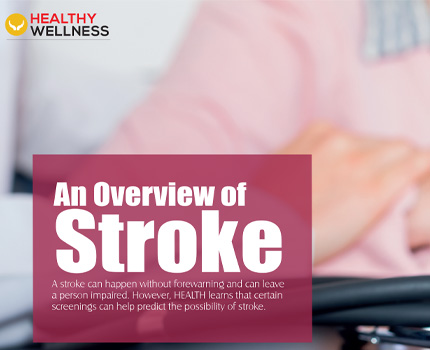 A stroke can happen without forewarning and can leave a person impaired. However, HEALTH learns that certain screenings can help predict the possibility of stroke.
A stroke can happen without forewarning and can leave a person impaired. However, HEALTH learns that certain screenings can help predict the possibility of stroke.
Defined
According to Dr. Sameh Al Sheikh, CEO and Founder of Al Borg Medical Laboratories, strokes are becoming more common now and at an even younger age. “A stroke happens when the blood supply to the brain is decreased or blocked allof- a-sudden,” explains Dr. Al Sheikh. “If left without a source of blood and oxygen, the cells of the brain will be injured or may die.” Unlike other parts of the body, the death of brain cells is permanent, usually leaving lasting disability, if not death.
Different Types
Essentially, there are two main types of stroke: Ischemic, which is caused by a blood clot that blocks one of the arteries that supply the brain with blood. The clot may originate from inside one of these arteries, or may migrate from a blood vessel that supplies other parts of the body to the brain. This is the most common type of stroke. The other is hemorrhagic, which is caused by the rupture of a blood vessel that can occur from the inside the brain by a congenital defect or high blood pressure, or from the outside as in from a head injury.
Triggers
Many factors can increase the risk of a stroke, tells Dr. Al Sheikh. “Some factors include being overweight or obese, physical inactivity, smoking, having a medical condition such as hypertension, diabetes, high cholesterol, or heart disease; all which may increase the risk of a stroke,” he says, while some inevitable factors include aging and/or having a family history of stroke. Men are generally are at higher risk of stroke than women.
Stroke Diagnosis
If a person has had a stroke, Dr. Al Sheikh explains that the diagnosis of a stroke currently relies on non-laboratory testing, including a physical examination and imaging studies such as CT and MRI. “Finding laboratory tests that could be used specifically in stroke screening diagnosis and treatment is still in the research phase,” he says, still, there are possible biomarkers that could be helpful in risk assessment which include Lp-PLA2, N-methyl-D-aspartate neuroreceptors (NMDAR), and NTproBNP. “There are many other laboratory tests that may be of help in diagnosing and managing stroke such as Complete Blood Count (CBC), coagulation studies, blood glucose, lipid tests, and electrolytes,” he notes.
Pre-Warning Signs
If someone feels one or more of the following signs, he/she should immediately seek medical help:
- Sudden weakness of the face, arm, or leg.
- Slurred or strange speech.
- The sudden inability to walk, loss of balance, or coordination.
- Severe headache with no known cause.
- Trouble seeing with one or both eyes.
Preventive Screenings for Strokes
If a person has a genetic susceptibility to stroke or had a stroke before, Dr. Al Sheikh points out there are possible biomarkers that could be helpful in risk assessment; these include: Lp-PLA2, N-methyl-D-aspartate neuroreceptors (NMDAR), and NTproBNP.
Prevention is Better than the Cure
- Preventive measures involve identifying risk factors such as hypertension, diabetes, coagulation disorders, and irregular heartbeats, so they can be treated with medications.
- It is advised that people at the age of 40 should start thinking about performing some tests on a screening basis including Complete Lipid Panel Screening to measure four different kinds of lipids in blood (Cholesterol, HDL, LDL and triglycerides), blood sugar levels, and high sensitive CRP levels in blood.
- Carotid artery disease screening and ECG screening for irregular heartbeat (AF) are also advised.

